By Dan Venning
At the end of 2019, London’s theatre was preparing for a crisis. The specter of Brexit was looming, and the snap election that had the potential to confirm, further delay, or potentially lead to a cancellation of the United Kingdom’s departure from the European Union was scheduled for 12 December 2019. This occurred almost precisely at the midpoint of my visit, during which time I saw fourteen shows with a group of my students. Several of these productions dealt, in one way or another, with the United Kingdom’s place in an increasingly globalized society which, through centuries of imperialism, the UK had helped to create. Additionally, many of the shows engaged with crucial questions that have been gaining traction worldwide over the past decade: structural racism and sexism, microaggressions, justice, the #MeToo movement, and the ways marginalized people have struggled to be heard and find representation, and have been silenced. My report assesses these shows not in the order in which I saw them but in three broad categories: innovative engagements with early modern English drama, creative reimaginations of pop culture products, and shows explicitly reckoning with questions of race, imperialism, and marginalization. It is worth noting, however, that although the plays in this third category explicitly focused on this topic, many of the fourteen shows throughout all three of these groupings were deeply intersectional in their focus on inclusivity and cultural engagement, and addressed, either directly or indirectly, the issues that were dominating global politics and cultural discourse at the time.
I. Innovative Engagements with Early Modern English Drama: Teenage Dick (6 December 2020), Richard III (17 December 2019), The Taming of the Shrew (11 December 2019), and The Duchess of Malfi (14 December 2019).
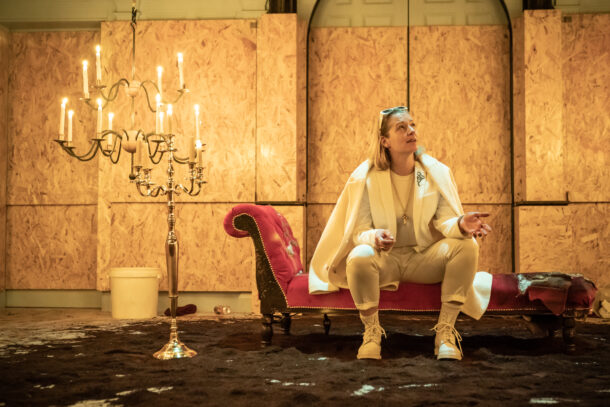
Richard III, by William Shakespeare, directed by Sean Holmes and Ilinca Radulian at the Wanamaker Playhouse in Shakespeare’s Globe. Photo: Marc Brenner.
In a fortuitous coincidence, Shakespeare’s Globe was staging Richard III, with the same ten-actor cast who had performed in their abridged Henry VI production earlier in the season, at the same time as the Donmar Warehouse was opening a new production of Mike Lew’s modern high-school take on Richard III, Teenage Dick, which is written for a cast of six and requires two disabled actors. I reviewed the Public Theater’s 2018 production of Teenage Dick, which was directed by Moritz von Steulpnagel and written for Gregg Mozgala, an actor with cerebral palsy who founded The Apothetae, a theatre company dedicated to producing works that explore “the Disabled Experience.” Michael Longhurst’s production of Teenage Dick at the Donmar Warehouse was the UK Premiere of Lew’s groundbreaking play, and was lightly rewritten to feature Daniel Monks, an Australian actor with hemiplegia. Unfortunately, I attended this production during previews and for that reason, the Donmar requested I not discuss its challenging production of this noteworthy play in my report. However, Sean Holmes and Ilinca Radulian’s production of Richard III at Shakespeare’s Globe’s indoor Wanamaker Playhouse, featuring Sophie Russell as Richard, proved just as invigorating and contemporary as Lew’s adaptation.
In the past, I’ve been somewhat unhappy with some of Shakespeare’s Globe’s productions: their focus on “original practices” in spaces designed to replicate the Globe and Blackfriars have felt like museum theatre with a few exciting moments—often viewed from obscured angles in uncomfortable seats. Thankfully, Holmes and Radulian’s Richard III was easily the most vital production I’ve seen at Shakespeare’s Globe, riveting even with one of the assistant directors serving as a script-in-hand understudy for some of the supporting parts. Russell played Richard without any (physical) disability—but Richard was now a woman, marginalized and undervalued by everyone around her. Her glee at tormenting those she killed as she rose (and tried to cling) to power was intensified by designer Grace Smart’s costumes, lighting, and set. Shakespeare’s Globe usually avoids complex sets, but here Smart made great use of a wooden stage covered in a pile of dirt. Richard was present at every single murder, and always wore a pristine white costume, often with absurdist touches: sometimes a pantsuit (but with white combat boots and sunglasses), at other points a white jersey with the name “Richard 03” emblazoned on it, at one moment a sombrero. One of her henchmen, most frequently Ratcliffe, creepily played by John Lightbody, would turn on a florescent lamp—harshly disrupting the Wanamaker’s candle-lit aesthetic—and Richard would brutally murder her victim, her white costume getting covered in stage blood, dirt, and other grime. She would merrily exit, and return moments later after a lightning-fast quick change in another unblemished white costume. The ten-actor cast made for particularly potent ghosting of Richard’s victims during the scene when she was confronted by apparitions of her victims, played by the same actors as her few remaining underlings. Also particularly noteworthy was Steffan Donnelly who, in a parallel to Russell’s gender-conscious Richard, was cross-gender cast as Margaret and appeared at the end as Richmond to offer a moment of respite and regeneration as he planted a tree in the dirt. But the real star remained Russell, who was simultaneously hilarious and terrifying, a woman whose rage against the patriarchy we could empathize with, but whose methods and joy in victimizing others placed her firmly among the noteworthy Richards of the last decade who have appeared onstage to critique a growing global tide of authoritarian populism.
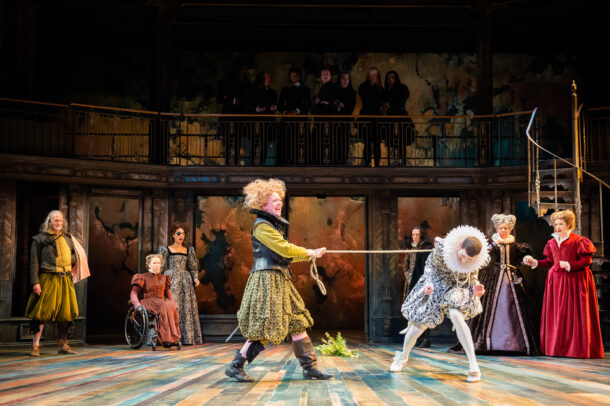
The Taming of the Shrew, by William Shakespeare, directed by Justin Audibert for the RSC at the Barbican Centre. Photo: Ikin Yum.
Sadly, neither Justin Audibert’s cross-gender production of The Taming of the Shrew for the RSC (at the Barbican), nor Rebecca Frecknall’s staging of John Webster’s The Duchess of Malfi at the Almeida, proved anywhere near as successful, despite the potential for these productions to engage in invigorating ways with patriarchal oppression of women both in Shakespeare’s time and the present day. In Audibert’s Shrew, the problem—which certainly exists in Shakespeare’s play and requires deft directing to address—was one of tone. Audibert reversed the gender of all the characters, imagining a matriarchal society in which Baptista (Amanda Harris) had two sons, Katherine (Joseph Arkley) and Bianco (James Cooney). Into this world swept the fierce Petruchia (Claire Price), determined to win and humble Katherine. Yet Audibert failed to either successfully address the sexist violence in Shakespeare’s text or to consistently craft comedy. Bianco’s suitors Lucentia (Emily Johnstone), Hortensia (Amelia Donkor), and particularly Gremia (Sophie Stanton), who glided across the stage as if floating, came from a world of topsy-turvy hilarity in which the viciousness of Petruchia’s abuse of Katherine seemed deeply out of place. The reversed gender of the characters did not make Petruchia’s methods of “taming” Katherine—which conform uncannily to the CIA’s “enhanced interrogation” tortures—any more palatable. Hannah Clark’s Elizabethan costumes and Stephen Brimson Lewis’s simple, two-tiered stage evoking early modern theatres only highlighted that Shakespeare’s play is deeply discordant in our world today, even when we see it staged with female characters in positions of power.
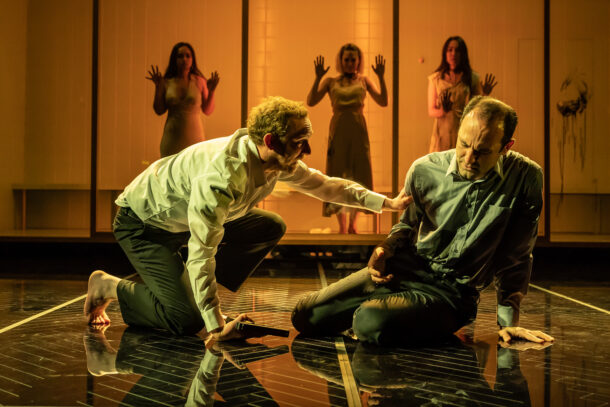
The Duchess of Malfi, by John Webster, directed by Rebecca Frecknall at the Almeida Theatre. Photo: Marc Brenner.
Frecknall’s take on The Duchess of Malfi was almost diametrically the opposite of Audibert’s approach, but no more successful, and certainly a disappointing follow-up to the visceral and feminist Summer and Smoke that I had seen the year previously. Webster’s text is, as written, a terrifying nightmare, with stunning set pieces, including the psychological torture of the imprisoned Duchess when she is given a severed hand, shown “the artificial figures” (bodies appearing to be her husband and children), and confronted by eight dancing madmen. In another stunning set piece in Webster’s text, one of the Duchess’s evil brothers, a Cardinal, dons a soldier’s regalia; after her murder, her other hateful brother is stricken with “lycanthropia,” believing himself a werewolf, digging up bodies, but while “a wolf’s skin was hairy on the outside / his on the inside” (5.2.17-18). When the titular character, having undergone horrors and facing death, declares “I am the Duchess of Malfi still” (4.2.152). Her words are an electrifying cri de coeur that articulate proto-feminist resilience in the face of oppression. Yet Frecknall’s production, for some reason, instead of centering on Lydia Wilson as the titular Duchess, seemed to focus on her ill-fated but good-hearted husband Antonio (Khalid Abdalla) and the men—her evil brothers the Cardinal (Michael Marcus) and Ferdinand (Jack Riddiford), and the opportunistic and amoral Bosola (Leo Bill)—who abuse her and other women. Chloe Lamford’s bland, ultramodern set seemed a bit on-the-nose, with a glass box upstage that came to contain the bodies of the women including the Duchess and Ferdinand’s other victims. This glass box seemed almost directly cribbed from Lizzie Clachan’s set for Simon Stone’s riveting (and again, ultramodern) adaptation of Yerma that premiered at the Young Vic in 2016 and came to New York’s Park Avenue Armory in 2018. However, unlike that astounding production, Frecknall’s contemporary Duchess of Malfi sapped its play of affective power and failed to deliver any feminist message.
II. Pop Culture Remixed in Contemporary Musicals and an Adaptation of a Young Adult Novel: SIX (8 and 15 December 2019), Girl from the North Country (18 December 2019), Ghost Quartet (2 December 2019), and The Ocean at the End of the Lane (9 December 2019).
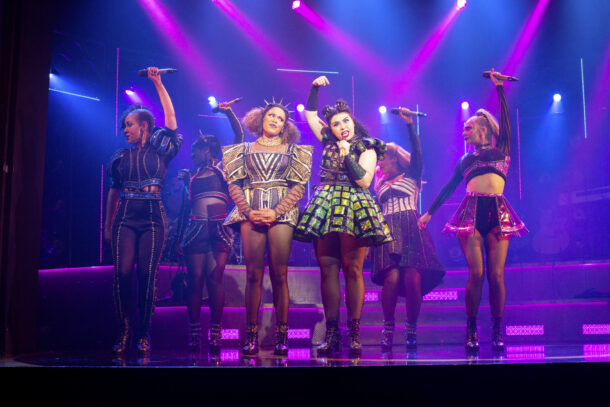
Six, by Toby Marlow and Lucy Moss, directed by Lucy Moss and Jamie Armitage at the Arts Theatre in the West End. Photo: Eleanor Howarth.
In contrast, unbridled and joyous feminism in the face of oppression was on prominent display in Toby Marlow and Lucy Moss’s Six (“Divorced Beheaded Live!”) at the Arts Theatre in London’s West End, directed by Moss and Jamie Armitage. After its runaway success at the Edinburgh Fringe in 2017, an initial hit run on the West End, and a UK National Tour, Six had been performing in a usually sold-out open run at the Arts Theatre since early 2019. During that time, a North American tour of Six began and productions opened in Australia and on Norwegian Cruise Lines. The Broadway production of Six was set to open on 12 March 2020 and had been playing to sold-out preview audiences; theatres were shuttered due to the coronavirus pandemic only hours before the opening. This was the only production I attended twice during my time in London and it was readily apparent why it has become such a global hit: its creators seamlessly blend catchy pop hooks and clever lyrics with an intersectional feminist historiography to reframe Tudor history on Catherine of Aragon, Anne Boleyn, Jane Seymour, Anna of Cleves, Katherine Howard, and Catherine Parr rather than on the crazed monarch to whom they had all been married. The show begins as a competition over which of the queens was treated the worst by Henry VIII, but ends, during the number “Six,” with a rejection of female competition as the women honor each other’s experiences and reject a hierarchy of suffering, choosing to celebrate female solidarity. Gabriella Slade’s flashy costumes, Carrie-Anne Ingrouille’s athletic choreography (including hand-held microphones as at a pop concert), and the rocking accompaniment of the all-female “Ladies in Waiting” band helped endear the production to legions of teenage girls—many of whom came to the theatre dressed up as their favorite queen, taking selfies in a bedazzled mirror in the lobby. But the show was no less exciting for a male historian and professor of theatre as I reveled in the way Marlow and Moss (who were both twenty-six years old in 2019, far closer in age to my students than to me) blended the aesthetics of intimate avant-garde theatre and stadium pop music to craft their show. The Arts Theatre is a small West End house, with a capacity of only 350, and Six runs 75 frenetic minutes without an interval. During the final encore, “Megasix,” audience members are encouraged to take out their mobile phones and photograph or record—an event common at concerts but usually forbidden in the theatre. The cast, who often rotate through roles, was also superb—albeit rather different each time I saw the production. Swing and Dance Captain Collette Guitart excelled as both Katherine Howard on 8 December and Catherine of Aragon on 15 December. Vicki Manser, in her last performance in the role as Howard, played excitedly to an audience of fans on the 15th. Hannah Stewart was particularly heartrending singing Jane Seymour’s “Heart of Stone” on the 15th; the role had been a bit vocally challenging for Cherelle Jay on the 8th, but Jay shone as an alternate for Anna of Cleves on the 15th. Courtney Bowman was superb as Anne Boleyn on both nights. And on the 8th, Marlow was in the Balcony, jubilantly enjoying his show with everyone else: after the performance he gladly took photos with my students and other audience members.

Dan Venning, Toby Marlow, and Union College students in the lobby of the Arts Theatre after Six. Photo: Isabel Dollar.
Like Six, Conor McPherson’s Girl from the North Country was slated for a Broadway run that was delayed due to the global coronavirus pandemic. Both were created in 2017, and like Six, Girl from the North Country has had successful runs in numerous theatres: first at London’s Old Vic, then in a limited run on the West End at the Noël Coward Theatre, at the Public Theater in New York, in Toronto, and then on the West End again at the Gielgud, where I saw it on 18 December 2019. Unlike Six, however, Girl from the North Country was able to open on Broadway, one week before the pandemic put everything on pause; Ben Brantley gave it a glowing review in the New York Times, calling it “ravishing and singular.” The show, written and directed by McPherson, is a Bob Dylan jukebox musical, set in Duluth, Minnesota in 1934, during the heart of the depression. Narrated by the ghostly town doctor, the plot—if there is one—concerns the diverse stories of the residents at Nick Laine’s (Donald Sage Mackay) financially underwater boarding house. In most cases, the stories McPherson crafts for these characters are only partial or fragmentary. For example, we only see the end of the relationship between Nick’s son, the alcoholic Gene (Colin Bates) and his girlfriend Kate (Gemma Sutton). Nick’s adopted daughter, Marianne (Gloria Obianyo) is pregnant and she never precisely reveals who the father is. Nor is it exactly clear who is the titular character: perhaps Marianne, or Nick’s wife, Elizabeth (Katie Brayben), who suffers from dementia. Although race is clearly a central concern in this color-conscious production (Nick, Elizabeth, and Gene are all white but Marianne is Black, as is Nick’s lover, the widow Mrs. Neilsen [Rachel John]), it is never clear exactly what McPherson is trying to say about race in America in the early twentieth century, even when the boxer Joe Scott [Shaq Taylor] sings “Hurricane.” Bob Dylan’s songs, which interrupt the action in the vein of Sondheim or Kander and Ebb’s concept musicals, as opposed to springing organically from the plot in the manner of Rodgers and Hammerstein’s book musicals, were the highlight of the show. Simon Hale’s orchestrations and arrangements for a large-cast ensemble musical with violin, mandolin, guitars, and double bass, broadened and deepened the sound of Dylan’s American anthems. But for all its beauty, I ultimately found the show mystifying: wonderfully produced and compelling in most moments, but signifying nothing.

Girl from the North Country, written and directed by Conor McPherson, with music and lyrics by Bob Dylan, at the Gielgud Theatre in the West End. Photo: Cylla von Tiedemann.
Dave Malloy’s Ghost Quartet is similarly mystifying, largely because the plot(s) of this musical written for a cast of four (who also play all the instruments) is almost impossible to unpack. But this musical, which was the first show I saw on my 2019 visit to London, was a resounding success. Directed by Bill Buckhurst, it was the first production to appear in the new Boulevard Theatre in the heart of London’s Soho. The intimate 165-seat venue retained some of the historic neon signs for the burlesque club Raymond Revuebar that once inhabited the site, and was set to present an ambitious inaugural season. I had seen Malloy’s song-cycle at the Bushwick Starr around Halloween in 2014, with Malloy performing alongside Brent Arnold and his Natasha, Pierre, and the Great Comet of 1812 costars Brittain Ashford and Gelsey Bell. The show mixes elements of Edgar Allan Poe’s “The Fall of the House of Usher” with The Arabian Nights, fairy tales, classic ballads, a murderous rivalry between sisters, and whiskey. The songs are listed in a four-sided “track list” and revel in interwoven, circular storytelling. Ultimately, the characters are all ghosts, haunting the stage for a moment, at once each other’s lovers, sisters, children, best friends, parents. Buckhurst’s production was staged in the round with objects seemingly magically springing from designer Simon Kenney’s set of boxes. Buckhurst clearly seized upon the “Arabian Nights” aspect of Ghost Quartet, recognizing that it is crucial to have actors of color, particularly of middle eastern or South Asian heritage, in this show. Buckhurst cast a far more diverse group of actors than in the original production in New York: the Pakistani-British actor Maimuna Memon was a particular standout. Carly Bawden, whose vocal purity shone in “Starchild” and “Hero,” the Italian actor and musician Niccolò Curradi, and Zubin Varla, who is of Parsi Indian heritage, were also superb. The show was generally the favorite among the students studying with me in London, and a great way to kick off the trip. It will be exciting to see what the Boulevard produces next once theatres reopen.
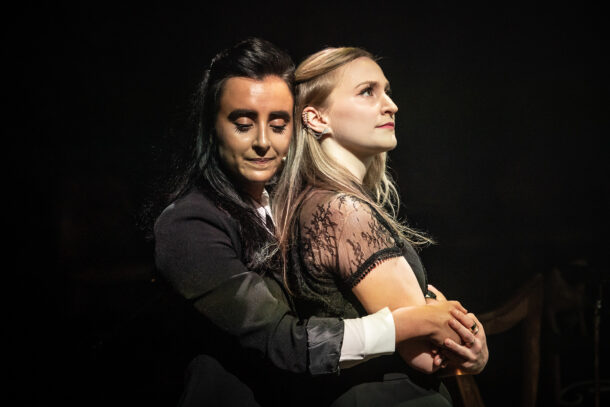
Ghost Quartet, by Dave Malloy, directed by Bill Buckhurst at the Boulevard Theatre. Photo: Marc Brenner.
The Ocean at the End of the Lane, which was adapted by Joel Horwood from a young adult novel by immensely popular author Neil Gaiman and directed by Katy Rudd—with movement by Steven Hoggett—for its premiere in the National Theatre’s Dorfman Theatre, was a major success with critics. It earned three nominations for the delayed 2020 Olivier awards, including for Best New Play, with Paule Constable winning for her haunting lighting design. Dealing with issues of abuse, trauma, loss, memory, forgetting, and aging, the play begins with a man (Justin Salinger) going home for his father’s funeral and rediscovering lost memories from when he was a Boy (Samuel Blenkin). The Boy and his neighbor, Lettie Hempstock (Marli Siu) went on a quest to save his family (the Boy’s father, now played by Salinger), and perhaps the world itself, from his father’s new companion, Ursula (Pippa Nixon), who was actually an otherworldly mind-controlling monster, and reality-devouring “hunger birds.” Although the story can be read as a modern magical realist fairy tale, it also works when seen metaphorically as the imaginative lens through which the Boy and Lettie see their world. The monsters were effectively crafted through puppetry and Hogget’s signature use of stage movement. However, the show also felt, to some degree, like a recycling of Hoggett’s signature tricks that have been seen in numerous shows like Black Watch, The Curious Incident of the Dog in the Night-Time, and, most similarly, Peter and The Starcatcher. Hoggett’s movement design, alongside Samuel Wyer’s puppets, Constable’s lighting, Ian Dickinson’s sound design, Jamie Harrison’s “magic and illusions design,” Gaiman and Horwood’s plot, excellent performances from the whole cast, Jherek Bischoff’s affecting musical compositions, and Rudd’s precise directing, led to a wonderfully effective production. The show compellingly provoked jump scares in one moment and tears at the end. But it felt a bit like a well-worn melodramatic trick, guaranteed to impress audiences without delivering any clear message about the crucial issues at its core.
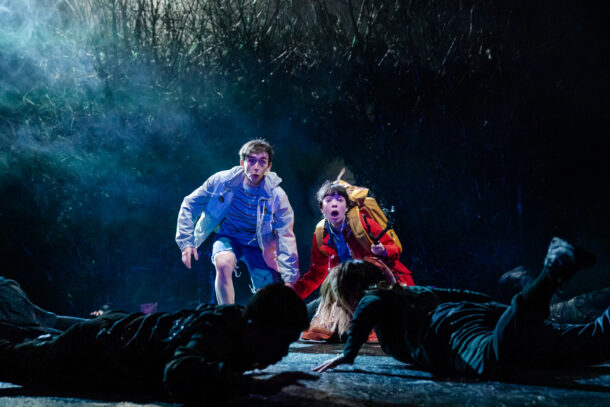
The Ocean at the End of the Lane, based on the novel by Neil Gaiman, adapted by Joel Horwood, directed by Katy Rudd at the National Theatre’s Dorfman Theatre. Photo: Manuel Harlan.
III. Race, Imperialism, Marginalization, and Britain’s Reckoning with its Past: Translations (3 December 2019), ‘Master Harold’ … and the Boys (17 December 2019), Three Sisters (19 December 2019), Death of a Salesman (4 December 2019), A Kind of People (10 December 2019), and Fairview (20 December 2019).
The last set of shows I am discussing in this report explicitly engaged, either in their texts or through striking directorial concepts, with crucial issues of our time, most notably race and British imperialism. Three of these shows were at London’s National Theatre: it was clear that, as Brexit loomed, the National sought to engage with the legacy of colonialism and Britain’s place on the world stage. Two of the productions were revivals of plays written only two years apart, which are now both roughly forty years old: Brian Friel’s 1980 play Translations and Athol Fugard’s 1982 play ‘Master Harold’ … and the boys. Together, these productions simply yet incisively explored the various failures of British imperialism and the damage such ventures perpetrated in both Ireland and Africa. The third, Inua Ellams’s Three Sisters, was a new play, a close adaptation of Chekhov transposed to the period from 1967-1970, during the Biafran war in Nigeria.
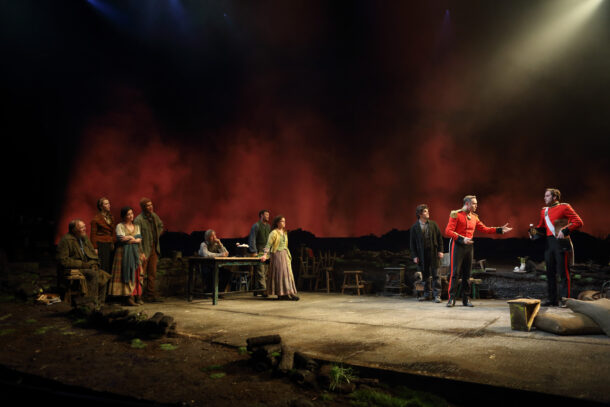
Translations by Brian Friel, directed by Ian Rickson at the National Theatre’s Olivier Theatre. Photo: Catherine Ashmore.
I reviewed Translations and Master Harold in greater depth in Theatre Journal and thus will write about them only briefly here. Rickson’s production of Translations, starring Ciarán Hinds as the Irish hedge school master Hugh and Fra Fee as his wayward son Owen, was a restaging (with many new cast members, including Fee and Jack Bardoe as the English Lieutenant Yolland) of a production that had opened a year-and-a-half earlier, in 2018, in a sold-out run. Unlike many productions created for the National’s massive Olivier stage, Rickson’s Translations did not make use of the Olivier’s magnificent drum revolve and its potential for rotating stages, or for raising and lowering actors from depths below the stage. Instead, Rae Smith’s single set covered the stage in sod and dirt, with a simple wooden platform, a few chairs and tables, and a staircase into a house stage right indicating Hugh’s hedge school in the rural landscape of the Irish-speaking community of Baile Beag (Ballybeg), County Donegal, in 1833. Actors would enter and exit over an upstage hill, as if having traversed through farmland to reach the school, and the realism of the design was reinforced not only by Smith’s gorgeous period costumes but also through the scent of peaty moss dispersed throughout the massive auditorium. Rickson’s production highlighted the transformative power of language, showing how the renaming of a location on a map, or of Fee’s Owen into “Roland,” as the British soldiers call him, can possess a constitutive power.
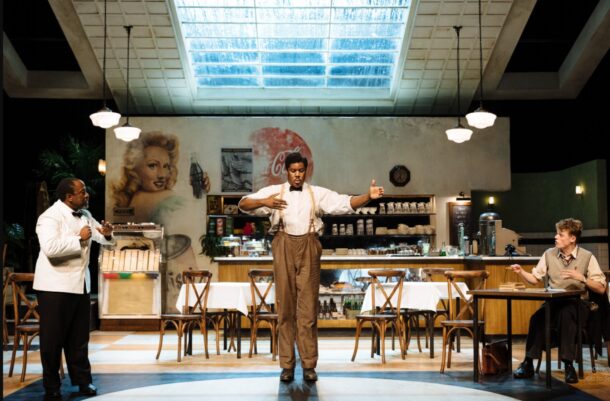
‘Master Harold … and the Boys, by Athol Fugard, directed by Roy Alexander Weise at the National Theatre’s Lyttelton Theatre. Photo: Helen Murray.
Roy Alexander Weise’s ninety-minute, intermission-free production of Athol Fugard’s ‘Master Harold’ . . . and the boys in the National’s smaller Lyttelton space managed to seem consistently present, relevant, and expansive in scope, despite Rajha Shakiry’s period costumes and almost claustrophobic café set. One could wonder what a play so frequently read and taught could gain from Weise’s production, which, for the most part, faithfully and precisely staged Fugard’s text, almost without any apparent directorial concept. Yet the captivating performances from Lucian Msamati as Sam, Anson Boon as Hally, and Hammed Animashaun as Willie made this production an astounding theatre-going experience, utterly compelling for every moment of those ninety minutes. Animashaun’s abilities as a dancer were luminous: his not-so-bright, slightly clownish Willie transformed completely as he began dancing. (Animashaun’s skills as a dancer can also be seen on extraordinary display in his performance as Bottom in Nicholas Hytner’s 2019 queer and immersive A Midsummer Night’s Dream, staged for the Bridge Theatre and broadcast globally through National Theatre Live screenings.) The final moments of Weise’s production particularly highlighted the continued relevance of Fugard’s play. As the jukebox played and Willie prepared to walk home, Shakiry’s café set slid away, revealing an expansive ballroom hidden there all along. Weise’s production was clearly showing that Sam and Willie’s dream of a beautiful world, a restorative “world without collisions,” can be possible if we make the effort to work together toward it. And following the curtain call (which was quite extended, as the thunderous standing ovation continued for some time when I saw the production on its closing night), the three actors embraced, modeling the sort of reconciliation and mutual understanding the world needs if we are to achieve such a dream.

Three Sisters, by Inua Ellams after Anton Chekhov, directed by Nadia Fall at the National Theatre’s Lyttleton Theatre. Photo: The Other Richard.
Inua Ellams’s Three Sisters also ran in the Lyttelton; for the final week of Fugard’s play, and the first week of Ellams’s, the two ran in the same space in alternating performances. Both plays contain the device of a character insisting that an employee who is essentially a family member address him by a formal name: the echo was unmissable. And Ellams’s play was similarly riveting throughout, although more than twice as long, running over three hours. Dedicated to the people of Biafra, Ellams’s play follows Chekhov’s plot but renames all the characters and places them firmly within the Nigerian context from 1967 to 1970. The role of the oldest sister, Lolo (Sarah Niles) is significantly expanded, as she struggles to implement a progressive and nationalist curriculum at the school where she teaches. The duel between the Tuzenbach and Solyony analogues, Nmeri Ora (Peter Bankolé) and Igwe (Jonathan Ajayi) is presented onstage and transformed into a traditional wrestling match—but the tradition is violated when Igwe shoots his rival and former friend after losing the match. Katrina Lindsay’s evocative period sets and costumes helped director Nadia Fall demonstrate how the specific national and cultural context influences Ellam’s take on the story of three educated sisters who lose their home and dreams. Ellams does not rely only on Chekhov, but also refers to the works of Christopher Okigbo and Chinua Acheba and theories of neocolonialism in order to unforgettably examine the individual suffering endured by colonized peoples even once they have achieved independence.

Death of a Salesman, by Arthur Miller, directed by Marianne Elliott and Miranda Cromwell at the Piccadilly Theatre on the West End. Photo: Brinkhoff Mogenburg.
Marianne Elliott and Miranda Cromwell’s production of Arthur Miller’s Death of a Salesman at the Piccadilly Theatre in the West End was certainly not an adaptation or new play, but at times felt like one due to its strong directorial concept and a few stage directions that were changed. Starring Wendell Pierce as Willy and Sharon D. Clarke (who won an Olivier for her performance) as Linda, Elliott and Cromwell’s production was not an all-Black production of Death of a Salesman (an example August Wilson specifically deplores in “The Ground on Which I Stand”), but a color-conscious one, in which the Loman family is Black in mid-twentieth-century America. Scenes took on new resonances when this Willy refused to accept a job from his white friend and neighbor Charley (Trevor Cooper), or had an affair with a white Woman (Victoria Hamilton-Barritt), or when the white Howard (Mathew Seadon-Young) calls an older Black man who works for him “kid.” Seadon-Young also doubled as Stanley, the waiter at the chophouse where Willy’s sons abandon him, and, in a notable departure from Miller’s text, instead of “as Willy turns, Stanley slips the money back into his jacket pocket,” this Stanley pocketed Willy’s forgotten cash, putting it into his own jacket pocket. Anna Fleischle’s set design also revealed the boiler in the house that Willy has contemplated using to commit suicide. Aideen Malone’s lighting and Carolyn Downing’s sound design were particularly effective in highlighting the disturbed fantasy in Willy’s flashback scenes, which were shown using unrealistic blue lighting and accompanied by jarring sounds along the lines of record scratches. Although the show was at times marred by genuinely poor dialect work in which several characters sounded nothing like Americans, let alone Brooklynites, Elliott and Cromwell’s concept, along with Pierce and Clarke’s commanding performances, showed just how much harder it would have been for a Black Willy Loman to achieve his flawed American Dream.
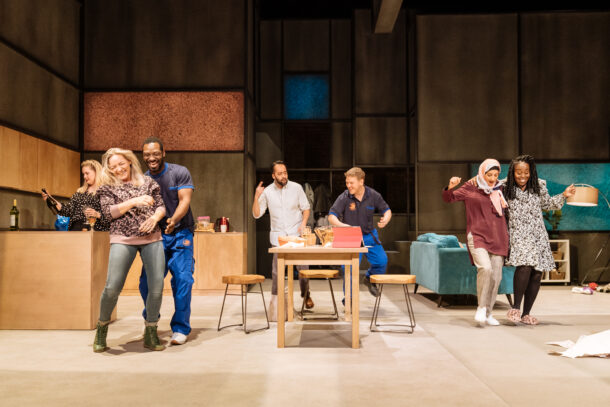
A Kind of People, by Gurpreet Kaur Bhatti, directed by Michael Buffong at the Royal Court’s Jerwood Theatre Downstairs. Photo: Manuel Harlan.
Gurpreet Kaur Bhatti’s new play A Kind of People at the Royal Court, directed by Michael Buffong, examined the intersections of race, class, sex, and immigration in present-day urban England. In the first scene, a dinner party in a cement-walled council flat (affordable housing), we meet all the characters: the mixed-race central couple, the white Nicky (Claire-Louise Cordwell) and Black Gary (Richie Campbell), Gary’s sister Karen (Petra Letang), their friend and Gary’s white colleague Mark (Thomas Coombes), their friends, the more affluent British Pakistani couple Anjum (Manjinder Virk) and Mo (Asif Khan), and Gary and Mark’s white supervisor, Victoria (Amy Morgan). Nicky and Gary’s three children remain unseen throughout the play. As the party in the first scene hits its stride, Victoria gets quite drunk and makes overtly racist comments to Gary; she is ushered out and given a cab. Designer Anna Fleischle’s set, which appeared realistically like heavy concrete-walled low-income housing, weightlessly slid away to reveal Gary’s workplace, where he has to endure constant microaggressions from Victoria and is passed over for promotions. Over the course of the play’s hour and forty-five minutes, the small cuts Gary and Nicky are forced to endure become too much and neither is able to contain their bottled-up rage. At times, it seemed as if Bhatti was cramming every possible degradation into her play, for example when Mark makes a pass at Nicky, letting her know he has always desired her and subtly suggesting that because of their shared race, they may have been a better match than her and Gary. But the fact that these indignities become exhausting to the audience in under two hours is part of the point: we realize what a tightrope Gary and Nicky must walk to survive from day to day, and that it is all too realistic for marginalized people to experience injustices with the relentlessness depicted in A Kind of People. Near the end of the play Nicky explodes in an act of violence towards her children that is nowhere near as lethal or permanent as Medea’s. In Buffong’s production of Bhatti’s play, this climax was thoroughly earned and every bit as devastating as that in Euripides’ classic, since we could see just how realistic it was. Bhatti’s play ends in a moment that is simultaneously heartrending and full of utopian hope, as Cordwell and Campbell portray Nicky and Gary twenty-five years earlier, at the start of their relationship, imagining that all the world can one day be theirs. We know just how hard this will be for them.
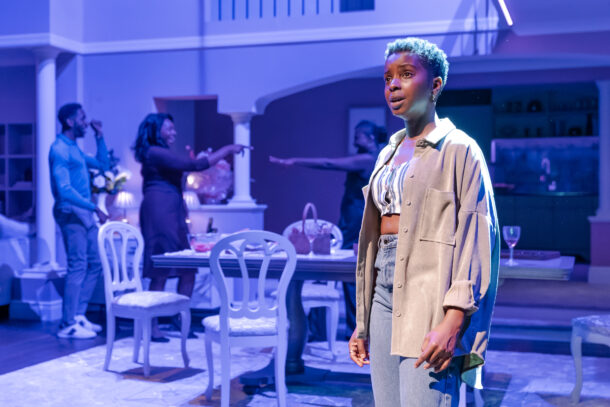
Fairview, by Jackie Sibblies Drury, directed by Nadia Latif at the Young Vic. Photo: Marc Brenner.
Jackie Sibblies Drury’s Pulitzer-winning Fairview, which received its UK premiere at the Young Vic under the direction of Nadia Latif, similarly ends with utopian vision, but one brought about by a destruction of the theatrical frame unlike any most audience members have seen before. I saw the original production, directed by Sarah Benson, at Soho Rep in New York, and ensured that this would be the last show my students would see in London: I wanted to leave the group of (mostly white) students profoundly challenged. It is hard to describe the action of Fairview without spoiling this powerful and important new play, but what begins like an uplifting middlebrow sitcom about an upper middle class African American family soon, through repetition and revision, turns into an invitation to the audience to directly confront the nature of representation and racism in the theatre. In Drury’s description, “Act One appears to be a comedic family drama. Act Two watches Act One. Act Two pushes further into Act One and tries to drive it forward to make Act Three.” Drury’s poetic opening stage directions, which include “Lights up on a negro: […] There is a glitch of some kind. […] she looks at herself in a pretend mirror hung on the fourth wall. It’s a very normal thing to have happen in a play” strikingly resonate as the play transforms into an engagement with the deep-seated power dynamics entangled with race in America. Latif’s production at the Young Vic was created for a far wider stage and much larger audience than that at Soho Rep (the Young Vic seats 550 while Soho Rep has only sixty-five seats) and this made the final moments all the more challenging. Donna Banya was particularly effective as Keisha, and her final monologue, during which she dropped her perfect American accent to speak in her native British dialect, demonstrated how the play could resonate as much in London as it did in New York.
Dan Venning has published articles in Asian Theatre Journal, Forum for Modern Language Studies, and Performing Arts Resources, as well as numerous chapters in scholarly edited collections, book reviews, and performance reviews in a broad range of scholarly journals. He is working on a book about Shakespearean performance and nation-building in nineteenth-century Germany. Before entering academia, he was the Associate Dramaturg at the California Shakespeare Theatre.

‘
European Stages, vol. 16, no. 1 (Fall 2021)
Editorial Board:
Marvin Carlson, Senior Editor, Founder
Krystyna Illakowicz, Co-Editor
Dominika Laster, Co-Editor
Kalina Stefanova, Co-Editor
Editorial Staff:
Alyssa Hanley, Assistant Managing Editor
Emma Loerick, Assistant Managing Editor
Advisory Board:
Joshua Abrams
Christopher Balme
Maria Delgado
Allen Kuharsky
Bryce Lease
Jennifer Parker-Starbuck
Magda Romańska
Laurence Senelick
Daniele Vianello
Phyllis Zatlin
Table of Contents:
- Berliner Theatertreffen Fights to Survive as Live Theatre Adapts to World Conditions by Steve Earnest
- Cultural Passport for Piatra Neamț Theatre Festival 2021 by Oana Cristea Grigorescu
- We See the Bones Reflected: Luk Perceval’s 3STRS in Warsaw, 2021 by Chris Rzonca
- Festival Grec 2021 by Maria Delgado and Anton Pujol
- Report from London (November – December, 2019) by Dan Venning
- A National Theatre Reopens by Marvin Carlson
- In Memoriam: Mieczysław Janowski, 1935 – 2021 by Dominika Laster
- In Memoriam: Jerzy Limon, 1950–2021 by Kathleen Cioffi
- In Memoriam: Marion Peter Holt
www.EuropeanStages.org
europeanstages@gc.cuny.edu
Martin E. Segal Theatre Center:
Frank Hentschker, Executive Director
Marvin Carlson, Director of Publications
©2021 by Martin E. Segal Theatre Center
The Graduate Center CUNY Graduate Center
365 Fifth Avenue
New York NY 10016
European Stages is a publication of the Martin E. Segal Theatre Center ©2021



